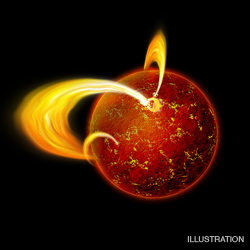For Release: August 30, 2006
NRAO RELEASE
A cosmic explosion seen last February may have been the "tip of an iceberg," showing that powerful, distant gamma ray bursts are outnumbered ten-to-one by less-energetic cousins, according to an international team of astronomers. A study of the explosion with X-ray and radio telescopes showed that it is "100 times less energetic than gamma ray bursts seen in the distant universe. We were able to see it because it's relatively nearby," said Alicia Soderberg, of Caltech, leader of the research team. The scientists reported their findings in the August 31 issue of the journal Nature.
The explosion is called an X-ray flash, and was detected by the Swift satellite on February 18. The astronomers subsequently studied the object using the National Science Foundation's Very Large Array (VLA) radio telescope, NASA's Chandra X-ray Observatory, and the Ryle radio telescope in the UK.
"This object tells us that there probably is a rich diversity of cosmic explosions in our local Universe that we only now are starting to detect. These explosions aren't playing by the rules that we thought we understood," said Dale Frail of the National Radio Astronomy Observatory.
The February blast seems to fill a gap between ordinary supernova explosions, which leave behind a dense neutron star, and gamma ray bursts, which leave behind a black hole, a concentration of mass so dense that not even light can escape it. Some X-ray flashes, the new research suggests, leave behind a magnetar, a neutron star with a magnetic field 100-1000 times stronger than that of an ordinary neutron star.
"This explosion occurred in a galaxy about 470 million light-years away. If it had been at the distances of gamma ray bursts, as much as billions of light-years away, we would not have been able to see it," Frail said.
"We think that the principal difference between gamma ray bursts and X-ray flashes and ordinary supernova explosions is that the blasts that produce gamma rays and X-rays have disks of material rotating rapidly about the central object," Soderberg said.
The powerful gamma ray bursts tap the tremendous gravitational energy of their black hole to produce strong beams of energetic radiation, while less-energetic X-ray bursts like the Feburary event tap energy from the strong magnetic field of the magnetar, the scientists speculated.
"This discovery means that the 'zoo' of cosmic explosions has just gotten more numerous and more diverse. It also means that our understanding of how the cores of massive stars collapse to produce this variety of explosions is less complete than we had thought," Frail added.
Multiwavelength follow-up observations were required by the team to measure the total energy release of the explosion. In particular, Soderberg adds that "Radio observations with the Very Large Array were additionally required to determine the geometry of the ejecta. We find that unlike typical GRBs which produce pencil-beam jets, this object more resembles a spherical explosion."
In addition to Soderberg and Frail, the research team includes Shri Kulkarni. Ehud Nakar, Edo Berger, Brian Cameron, Avishay Gal-Yam, Re'em Sari, Mansi Kasiwal, Eran Ofek, Arne Rau, Brad Cenko, Eric Persson and Dae-Sik Moon of Caltech, Derrick Fox and Dave Burrows of Pennsylvania State University, Roger Chevalier of the University of Virginia, Tsvi Piran of the Hebrew University, Paul Price of the University of Hawaii, Brian Schmidt of Mount Stromlo Observatory in Australia, Guy Pooley of the Mullard Radio Astronomy Observatory in the UK, Bryan Penprase of Pomona College, and Neil Gehrels of the NASA Goddard Space Flight Center. The National Radio Astronomy Observatory is a facility of the National Science Foundation, operated under cooperative agreement by Associated Universities, Inc.
MEDIA CONTACTS
Dave Finley, Public Information Officer
(505) 835-7302
dfinley@nrao.edu




